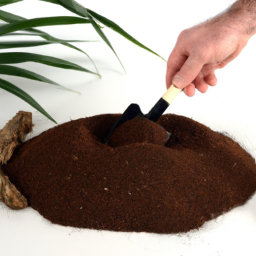How To Improve Sandy Soil For Gardening
Table of Contents []
How To Improve Sandy Soil For Gardening
How To Improve Sandy Soil For Gardening
Features of Sandy Soil for Gardening
When it comes to gardening, sandy soil is one of the primary soil types that needs to be considered. It has, however, a series of conditions that can make it difficult to use for gardening. Sandy soils are typically composed of a large quantity of small-sized particles. These particles are made up of sand, silt, and clay, all which are relatively small. This means that the nutrients are highly prone to draining away from the soil, but the soil is also light and well-aerated. This is great for roots, which can develop unencumbered by greater density soils.
Benefits of Sandy Soil for Gardening
As stated, sandy soils' main benefit is its light composition. It gives the gardener a greater advantage in regards to planting, tilling, and weeding. A lower composition means greater aeration and, thus, faster growth where oxygen is concerned. This is excellent for warm climates, as poorer draining soils can become waterlogged and prevent plants from growing as they should. It is also worth noting that even though nutrient loss is particular to this type of soil, it is easy to replenish the soil.
Pros and Cons of Sandy Soil for Gardening
The obvious benefit of sandy soil is its ability to absorb excess water, while the main disadvantage is that it doesn't retain enough of it. This takes us to the pros and cons of using sandy soil for gardening:
- Pros:
- Light soil that can be tilled and aerated easily
- Easily amended with organic matter
- Great for Banks and sloping soils
- excellent drainage of excess water
- Cons:
- Low water holding capacity
- Nutrients drain quickly from the soil
- High salinity of water can render bacteria useless
Case Studies of Using Sandy Soil for Gardening
1. Northeast Texas Master Gardener's Case Study: In Northeast Texas, one garden explorer shares their experience at trying to grow vegetables in sandy soil with limited success. With careful amending of compost, organic matter, and complex fertilizer combinations, they were able to grow a decent crop, albeit with lower yields than they had expected.
2. University of Rhode Island's Case Study: At the University of Rhode Island, researchers studied the effects of chemical amendments to sandy soils to improve vegetable yield. At the end of the experiment, researchers concluded that chemical amendments improved the vegetable yields significantly, with greater concentrations of iron and phosphorus providing the best results.
3. Texas A&M University's Case Study: Lastly, at Texas A&M University, researchers tested inorganic salt amendments to sandy soil, and found significant increases in yields. The salt amendments improved the water-holding capacity of the soil and made it easier for the plants to uptake nutrients through their roots.
Frequently Asked Questions of Sandy Soil for Gardening
- What is Sandy Soil?
- What is the Benefit of Sandy Soil for Gardening?
- What are the Disadvantages of Sandy Soil for Gardening?
Sandy soil is a soil type that is composed of a large proportion of small-sized particles, such as silt, sand, and clay. It is light and well-aerated, making it great for certain types of crops.
Sandy soils are light and well-aerated, which makes them great for warm climates. Additionally, they also drain well, and help prevent waterlogging in plants.
Sandy soils are not very water retentive, and they quickly drain away any nutrients present in the soil. This makes it difficult to maintain a balanced soil texture for gardening.
Mistakes People Make With Sandy Soil for Gardening
One of the most common mistakes made when gardening with sandy soils is to not amending it sufficiently. Sandy soils are already low in nutrients, so it is important to enrich them with organic matter and complex fertilizers. Additionally, watering too often and failing to provide adequate drainage can cause waterlogging of the plants and lead to root rot. Finally, many people fail to take into account the local environment when gardening with sandy soils, as certain areas lack the right type of soil amendments.
Best Practices For Improving Sandy Soil for Gardening
- Amending the soil regularly with organic matter, compost, and complex fertilizers.
- Take into account the local environment when gardening with sandy soils.
- Water the plants infrequently and make sure the soil has adequate drainage.
- Test soil pH levels regularly to make sure the soil is not acidifying.
- Make sure to remove weeds and add mulch to keep soils warm in the winter.
Summary
Sandy soils can be suitable for gardening, but they need to be handled with care. By amending it with organic matter, compost, and complex fertilizers, it is possible to create ideal growing environments for warm and, sometimes, even wet climates. The best practices also include testing soil pH levels regularly, removing weeds, and adding mulch to keep the soil warm in winter. By following these steps, it is possible to successfully garden with sandy soils.
Final Notes
Gardening with sandy soils can be a challenge, but it is possible to overcome the difficulties. It is important to include all the best practices outlined above, as well as take into account the local environment and climate. Knowledge of the soil type and regular testing of pH levels will ensure success in quiet any environment.
Conclusion
Overall, gardening with sandy soils is possible and it is possible to obtain a great yield from crops grown in it. However, it is important to be aware of the particular conditions of sandy soils and take the necessary steps to ensure success. From amending the soil with organic matter and complex fertilizers to considering the local environment and climate, it is possible to successfully create a home for the desired plants and obtain the desired yield.

Previous Page
Next Page